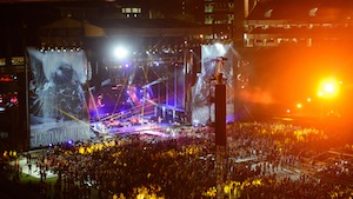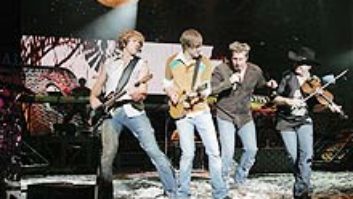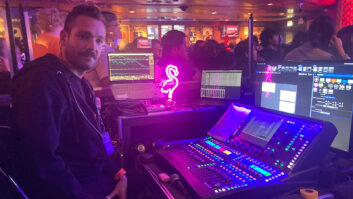Riding high in the saddle with a chart-topping single, “Ain’t Nothing ‘Bout You,” Brooks & Dunn have been out on a tour to promote their seventh album, Steers & Stripes. Stopping in about three dozen cities before the tour wrapped in August, the 12-bus, 8-truck production mostly followed the shed circuit, but Mix caught the show at Portland’s Rose Garden, one of the several arenas on the itinerary.
Three support acts contribute to over five hours of non-stop entertainment, with an Academy of Country Music all-star line-up appearing on the multi-level stage. CMA Album of the Year winner Toby Keith is on the bill, plus the act that briefly dethroned Brooks & Dunn as Duo of the Year — Eddie Montgomery (John Michael’s brother) and Troy Gentry. CMA’s Top New Male Vocalist Keith Urban is the first male country artist from Australia to have a Top 10 country single in the States, and Cledus T. Judd, country’s version of Weird Al Yankovic, appears between sets to spoof country hits and provide comic relief. (In Portland, Judd was absent due to his mother’s illness — we wish her a speedy recovery.) The traveling circus even includes a “Honky Tonk Hall of Fame” midway exhibit that sets up outside the venue — attractions include shorts supposedly worn by Elvis at his military physical and a piece of Patsy Cline’s plane wreckage.
Featuring multiple video screens, confetti cannons, and a special lighting and set design, this traveling big top with rock ‘n’ roll production values was put together by production manager Randy “Baja” Fletcher and tour manager Scott Edwards. Sound Image, of Escondido, Calif., who have supported Brooks & Dunn for the past seven years, once again provided sound services.
Tommy Welch mixes FOH for Brooks & Dunn on a Midas XL4. Eight years ago, when Bob Butler was mixing FOH, Welch joined as an over-qualified stage tech during a hiatus from mixing FOH (brought on by one too many Sawyer Brown outings). When Butler passed on a few years back, Welch stepped in to fill a big pair of shoes — not a day goes by that the crew doesn’t think of Butler, and you can feel his spirit looking after the production.
Welch’s mixing effects include a TC Electronic M2000 dual-effects processor, which he uses as both a vocal reverb and doubler or chorus, depending on who is singing lead. “I’m kind of a minimalist when it comes to effects,” explains Welch. An Eventide H3000 finds use on the backing vocals, and Welch also uses a pair of Yamaha SPX990s for instrument and drum reverbs, which are cued for program changes via MIDI from the Midas. Inserts include Drawmer 1960 compressors and 1961 equalizers used on vocals, kick and bass guitar, and Welch uses BSS 901 dynamic equalizers to help sit the acoustic instruments in a very active mix.
Dave “Hud” Haney mixes monitors on a Ramsa SX-1A that he calls “a tank,” no doubt referring to its roadworthiness rather than its handling characteristics; Haney reports that blind listening tests showed the Ramsa mic pre’s to be the sonic equal of those in the FOH XL4. Haney manages in-ear mixes for 10 musicians onstage, and the entire band is fitted with the latest version of Future Sonics’ single-driver in-ear monitors (IEMs). Six of the wireless systems, plus a spare and a cue mix, are Shure models, and Haney prefers the older PSM 600 model to the newer PSM 700. “The 600s sound better when they’re driven hard,” he explains.
To even out the ear mixes, Haney uses dbx Quantum processors as 4-band compressors. “The ear monitors tend to eat up a lot of bottom end energy, but you don’t get that back into your head,” Haney explains. He squeezes the lows and also the high-mid band, narrowly around 100 Hz and 2.5 kHz, to keep them from loading up at those frequencies. “Then, depending on the instruments in each mix, I use the other two bands to compress the hottest frequencies,” he adds. Haney also uses the onboard parametric EQ to customize the response for a couple of players who like their mixes brightened up above 5 kHz.
Four Lexicon PCM 80s and a PCM 70 are used as dedicated effects in the monitors. While the unit used for drum reverb is traditionally set up, being fed from the last pair of aux sends, the other reverbs are fed from channel direct outs and act as dedicated vocal reverbs for Brooks, Dunn, and backing vocalists Dwain Rowe (keyboards) and Tony King (rhythm guitar). A Yamaha REV500 is similarly used as a dedicated reverb for acoustic guitars. Haney also has six channels of Drawmer 1960 compression inserted on the vocal, kick and snare drum inputs.
Drummer Scott Hawkins also gets his hardwired in-ear mix supplemented with a pair of throne-mounted Aura shakers and a JBL single-18 sub. These are mixed and EQ’d through a Midas XL42 preamp, with the direct outputs of both the kick drum mic and kick drum trigger fed to the XL42’s 2×2 mixer inputs.
Haney also uses a Midas XL42 to manage the stereo FOH mix that gets sent to the sidefills, which consist of Sound Image Series V enclosures plus two double-18 subs. Thus, even if Ronnie Dunn pops an in-ear monitor out, he can still hear Welch’s FOH. Originally, Haney had set up a discrete monitor mix for sidefills. “You get to where you’re blowing away the front few rows,” Haney explains, “and it would tend to be mostly lead vocals and kick drum.” Using the house mix ensures that audience downstage-center gets the same mix as the rest of the audience, and the sidefill leakage obviously doesn’t upset the FOH mix, because it’s essentially the same.
Brooks and Dunn both sing through AKG C-420 headset mics and an AKG 900 Series Broadcast wireless system. Haney and backline tech Jeff Kersey use Brooks & Dunn’s spare mics to communicate, and the talkback system also includes an open mic that band leader Danny Millener uses to channel other musician’s requests to Haney during line check. Drummer Hawkins also has a headset mic that’s briefly opened when he counts off songs. Haney says talkback is the most important part of a stage that relies entirely on in-ear monitoring. “If you don’t do it properly, it can quickly drive you crazy,” he adds.
Other mics used onstage include an AKG D-5600 in the kick drum, Shure SM57s on snare and toms, AKG C-460s on hi-hat and ride cymbals, while stereo C-4000s are employed for overheads. Backing vocalists sing into AKG C-5600s. Lead guitarist Lou Toomy’s Vox AC30 is the only live amp onstage and is miked with a 57. The rest of the musicians’ instruments are fed direct, with Line 6 Pods employed for Millener’s bass, King’s rhythm, Troy Klontz’s steel, Charlie Crow’s lead and Kix Brooks’ electric. All musicians who go cordless use AKG wireless systems, which Haney claims to be the best.
Haney chooses not to use audience mics for the in-ear mixes, not just because his 56-input desk is loaded, but because he found the added ambience tended to irritate players and put more “kack” in the mix, even when properly managed with a volume pedal. “There’s enough open mics onstage that there’s plenty of ambience in the mix to hear the crowd roar,” he notes. And roar they do.
Sound Image provides a variety of consoles on this tour. Steve Law mixes fellow Aussie Keith Urban’s set on a short-frame PM 4000, which sports a pair of Tannoy System 800A active monitors on the meter bridge, while Mark Miles performs monitor chores on a Ramsa WR-S840. Allan Sullivan mixes Montgomery Gentry on half of a Gamble EX56, and Jeff Grenninger employs a Midas Heritage 3000 for their monitors. Dirk Durham mixes Tobey Keith’s set on the other half of the Gamble EX, and Barney Castro works a Yamaha M3000 for monitors.
Sound Image crew chief Pete McDonough is assisted by system technician Chuck Bogard and stage tech Jon Garber. The main speakers are Sound Image’s flagship JBL-loaded G-5 carbon-composite enclosures powered by QSC Powerlight 1.8 and 4.0 amplifiers — I first heard this system several years ago on a Melissa Etheridge show and had forgotten how good it sounds. Sound Image G-2 two-way boxes are positioned underneath the hang for downfill, and a dozen dual-18 carbon subwoofers are ranged on the floor.
System tuning is effected by TC Electronic 1128 equalizers and a 6032 motorized fader remote head. Welch shares this gear with the other FOH engineers — each is assigned 10 memory locations to organize their settings night to night — though it seems that there is much cooperation and sharing of thoughts on system EQ.
Brooks & Dunn’s set opens with a clown on stilts, fire-eaters juggle flaming sticks, a cowboy twirling a lariat and tour-rigger Michael McDonald dressed like Buffalo Bill rappelling down head first from the grid. The duo stays amped up for most of the show, but halfway through the set, in an acoustic segment, Dunn leaves Brooks on his own to perform “You’re Gonna Miss Me When I’m Gone,” dedicated to late NASCAR hero Dale Earnhardt. On “Neon Moon,” Dunn’s custom guitar lights up with a light blue crescent that matches the trim on the stage risers. The entire tour is sponsored by Gibson, and there is a veritable side-stage Guitar Center. Country music lovers won’t want to miss this circus as it meanders through the Midwest this month.
Mark Frink is Mix‘s sound reinforcement editor.







